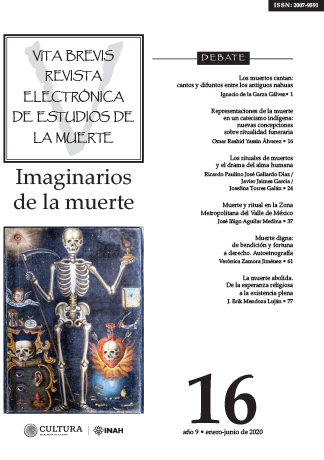Los rituales de muertos y el drama del alma humana
Keywords:
Soul, Worldview, Shamanism, ReincarnationAbstract
The rituals of human death aim to bring the soul of the human being to find a place for eternal rest, thereby appearing the concepts of worldview typical of shamanism; from where Heaven and Hell derive from the religions and their respective churches. We present various concepts of the soul, belonging to various forms of religious thought and relationships with the diversity of cults present in human societies. We emphasize the shamanic proposal encompassing two possibilities: First. The traditional one, historically popularized and that is sustained by the descent of the Soul of the deceased through the floors of the Underworld, to transcend the World of the Dead. Second. The one corresponding to a contribution, which is the result of what we have investigated with a Mexico City Urban Shaman, who supports his ideology in the concepts of the Shining Egg, fibers that comprise it, their opening of these when the person is dying and the consequence of it. Finally, we conclude why there is no reincarnation and from where the soul of the human being originates, as a shamanic proposal.
Downloads
References
Antropología y Teología, “Antropología teológica fundamental: el hombre como criatura de dios”, 6 de febrero de 2017, recuperado de: https://lateologiasinprejuicios.blogspot.com/2017/02/antropologia-y-teologia.html consultada el 16 de octubre de 2022.
Biblia Online, “Reina Valera 1960”, recuperado de: https://www.biblia.es/reina-valera-1960.php consultada el 16 de octubre de 2022.
Barrientos López, Guadalupe, Otomíes del Estado de México, México, cdi / pnud, 2004.
Blasco Cruces, Diego, La historia de la muerte. Creencias y rituales funerarios, España, Libsa, 2010.
Carrasco Álvarez, Sergio Melitón, “El hinduismo. 84 conceptos y definiciones para entender mejor el hinduismo y las clases de…”, 2008, recuperado de: https://xdoc.mx/documents/el-hinduismorepositorio-academico-5f891d1cdcfee 16 de octubre de 2022.
Chávez Balderas, Xavier, “Funerales mexicas”, Artes de México, núm. 96, noviembre de 2009, pp. 24-35.
Dendo Kyokai, Bukkyo, La enseñanza de Buda, Tokyo, Kosaido Printing, 2017, p. 49, recuperado de: https://efaidnbmnnnibpcajpcglclefindmkaj/https://www.bdk.or.jp/pdf/buddhist-scriptures/05_spanish/TheTeachingofBuddha.pdf consultada el 14 de octubre de 2022.
Echegoyen Olleta, Javier, “Alma-filosofía griega-presocráticos-sofistas-Sócrates”, Torre de Babel ediciones (blog), recuperado de https://e-torredebabel.com/alma-filosofia-griega-presocraticossofistas-socrates consultada el 1 de octubre de 2022. Diccionario enciclopédico de Biblia y teología (Biblia.Work), “El alma”, recuperado de: https://www.biblia.work/diccionarios/el-alma/ consultada el 2 de octubre 2022.
Eliade, Mircea, El chamanismo y las técnicas arcaicas del éxtasis, 2ª ed., México, FCE, 1976.
Espinosa Rubio, Luciano, “El sentido de lo religioso en Oriente”, Fragmentos de Filosofía, núm. 8, 2010, pp. 103-120, recuperado de: file:///C:/Users/pc_0372278/Downloads/Dialnet-ElSentido-DeLoReligiosoEnOriente-3621544.pdf consultada el 30 de octubre de 2022.
García López, Jesús, “El alma humana y otros escritos inéditos”, Cuadernos de Anuario Filosófico, núm. 21, 2007, pp. 19-22.
Graulich, Michel, “El sacrificio humano en Mesoamérica”, Arqueología Mexicana, vol. XI, núm. 63, pp. 16-21.
Halifax, Joan, Las voces del chamán, México, Diana, 1995.
Lagarrica Attias, Isabel y J.M Sandoval Palacios, Ceremonias mortuorias entre los otomíes del norte del estado de México, México, Libros de México, 1977.
Langdon, E. Jean, “¿Mueren en realidad los chamanes? Narraciones de los siona sobre los chamanes muertos”, Alteridades, núm. 12, 1996, pp. 61-75.
Lechuga, Ruth, “Rituales del Día de Muertos”, Artes de México, núm. 62, pp. 16-25.
León-Portilla, Miguel, “Memorial nahua de la muerte”, Artes de México, núm. 96, noviembre de 2009, pp. 43-51.
López Austin, Alfredo, “El ser humano en Mesoamérica”, Arqueología Mexicana, núm. 65, enero-febrero de 2004. ________, “La muerte en México prehispánico”, Arqueología Mexicana, vol. VII, núm. 40, noviembre-diciembre de 1999.
Martorell, Carmen, Manel Vallmajor y Joan Mora, “Benshen: los espíritus del individuo”, Revista Internacional de Acupuntura, vol. 10, núm. 4, 2016, pp. 131-146, recuperado de: https://www.elsevier.es/es-revista-revista-internacional-acupuntura-279-epub-S188783691630059X consultada el 14 de octubre de 2022.
Saavedra Cuevas, Jairo Eligio, Un estudio histórico sistemático al concepto de alma en el periodo patrístico, Santiago de Chile, Universidad Adventista de Chile, 2020, pp. 1-40.
Smith, Fred y Chad Brand, “¿Qué es el alma?”, Biblias Holman, 17 de agosto de 2020, pp. 1, recuperado de: https://bibliasholman.lifeway.com/que-es-el-alma/ consultada el 2 de octubre de 2022.
Torres, Delci, “Los rituales funerarios como estrategias simbólicas que regulan las relaciones entre las personas y las culturas”, Sapiens. Revista Universitaria de Investigación, vol. 7, núm. 2, diciembre de 2006, pp. 107-118, recuperado de: https://www.redalyc.org/articulo.oa?id=41070208 consultada el 25 de octubre de 2022.
Turok, Marta, “La ofrenda un derroche creativo”, Artes de México, núm. 62, pp. 48-55.
Downloads
Published
How to Cite
Issue
Section
License
Copyright (c) 2020 Instituto Nacional de Antropología e Historia

This work is licensed under a Creative Commons Attribution-NonCommercial 4.0 International License.



